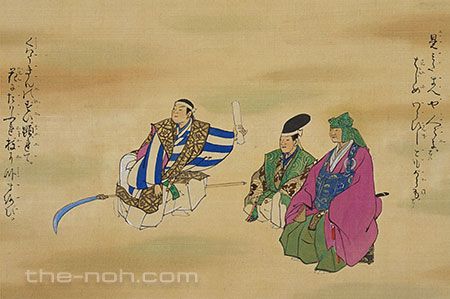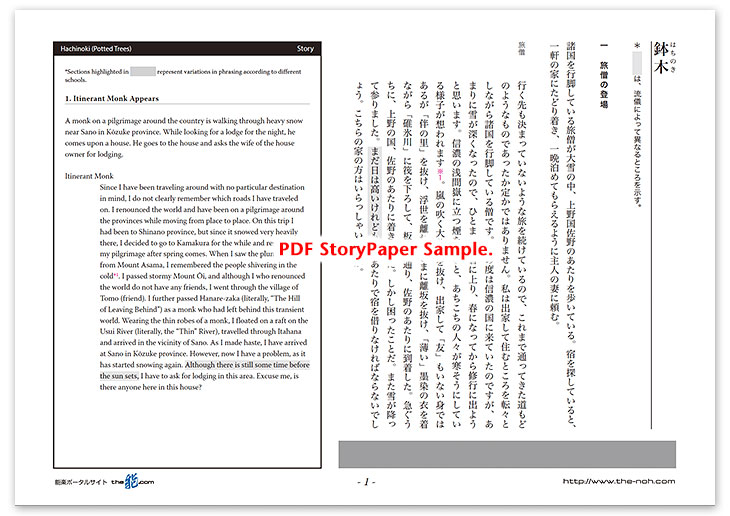
 Hachinoki (Potted Trees)
Hachinoki (Potted Trees)

![]()
These events take place during the Kamakura era (1185 or 1192 - 1333). On a day of heavy snowfall, an itinerant monk on a pilgrimage is traveling to Kamakura and stops at Sano (in present-day Gunma prefecture) in Kōzuke province (modern-day Gunma prefecture and part of Tochigi prefecture). Because the heavily accumulating snow prevents him from continuing his journey any further, he knocks on the door of one of the houses on the road and asks the wife of the house owner for a place to stay for the night. When the master of the house, Sano Genzaemon-no-jō Tsuneyo, returns home and meets the monk asking for a favor, he initially declines the request as they are too poor to have an overnight guest. However, accepting his wife’s suggestion, he runs after the monk (who had already left) and offers him lodging for the night. As the cold grows more severe, Tsuneyo puts his cherished, well-cared for potted plum, cherry, and pine trees into the fire pit and burns them in order to heat the room and treat well their guest, the monk. When the monk asks Tsuneyo what his name is, at first Tsuneyo hesitates to answer as his name is not worth revealing, but eventually he tells the monk his name and the story of his relatives cheating him out of his land and causing him to fall into the poverty. He also says that even though he leads a miserable life, he is prepared to scramble to Kamakura before anyone else to fight for the Shogun in the event that any emergency arises there. The next morning, while they express how much they will miss each other, the monk bids farewell and leaves Tsuneyo’s house.
Some days later, Hōjō Tokiyori, a retired Regent of the Kamakura Shogunate, musters the warriors in the eight provinces of the Kanto region. Hearing about these orders, Tsuneyo rushes to Kamakura, although dressed in shabby apparel. Tokiyori orders his subordinate warrior, Nikaidō, to find a warrior wearing ripped armor, carrying a rusty long-handled sword, and riding a bony horse and bring that warrior before him. Nikaidō orders his subordinate to find the miserably-dressed warrior, Tsuneyo.
Arriving before Tokiyori, Tsuneyo notices that the itinerant monk who once stayed his house is indeed the retired regent Hōjō Tokiyori. In fact, Tokiyori mustered his warriors in order to confirm whether Tsuneyo is true to his word. Tokiyori compliments Tsuneyo, who kept his word and came rushing to Kamakura, and promises to return the stolen land to Tsuneyo. Also, thankful for the three potted trees that were burned to keep him warm, Tokiyori bestows upon Tsuneyo three pieces of land associating with plum, cherry, and pine. With delight, Tsuneyo returns to his home in Kōzuke province.
![]()
This masterpiece, “Hachinoki (Potted Trees),” is said to be one of the favorite dramas of Shogun Tokugawa Ieyasu (1543-1616). This play, categorized as Fourth Group Noh, was especially popular during the Edo era (1603-1868), probably because it lauds the chivalry of the warrior class (bushido) and depicts a nobleman who travels around the countryside, his status hidden. Although there is no dashing, manly dance or eye-catching battle scene in this piece, the story itself is quite dramatic.
Tsuneyo, the lead character (shite) is neither a hero nor a feudal lord; he is merely a warrior of no distinction. However, while he enjoys watching the snow fall, he recalls a poem by Bai Juyi (772-846) included in Wakan rōei-shū (Collection of Japanese and Chinese Poems for Singing, circa 1013). He compares his encounter with the itinerant monk to a poem by Fujiwara no Teika (1162-1241) anthologized in Shin kokin waka-shū (New Collection of Poems, Ancient and Modern). And while cooking millet, he recites an old story in Zhen zhong ji (The World Inside a Pillow), a Chinese novel dating from the Tang dynasty. As such, he is described as an educated man with knowledge of classic literature and understanding of refined sentiments. Tsuneyo’s first line, “Oh, the falling snow is forming a fine blanket” is an important line because it determines the success of the entire play and establishes his character as one who maintains a dignified bearing, even while describing a scene of falling snow. In spite of his poverty, Tsuneyo has managed to enjoy growing trees in pots. As can be seen from the size of the stage prop, during this era, people grew potted trees to be quite large. Indeed, their size speaks to the value placed upon them by Tsuneyo, who spent many years growing them to be so large. Burning such special trees to make a fire to warm his guest shows his spirit of chivalry. Also, Tsuneyo is described as having the spirited determination, in the event of an emergency, to rush to Kamakura faster than anyone else once the call to muster has been issued by the Kamakura Shogunate, even though people may make fun of his shabby armor. Indeed, the expression describing Tsuneyo’s fighting spirit, “iza, Kamakura” (“an emergency in Kamakura”) originates from this play and has become a famous Japanese expression meaning, “in case of emergency.” Thus, Tsuneyo is described as a man of straightforward and strong character.
Hōjō Tokiyori (1227-1263), a supporting character (waki), was the fifth regent of the Kamakura Shogunate. He was called Saimyōji-dono (Lord Saimyōji) after he renounced the world and became a Buddhist monk. He is remembered as a politician who gave consideration to the life of commoners, which became the basis of a legend that he disguised his identity and traveled around Japan. Although the veracity of this legend is uncertain, Taiheiki (Chronicle of Great Peace) does describe him traveling through several provinces. Such legends inform the subject of this piece, “Hachinoki.” In this play, Tokiyori is described as a man having two characters: the humbleness of an itinerant monk and the noble bearing and dignity of the most powerful ruler of Japan.
Against the sentimental backdrop of Kōzuke province, covered in a heavy blanket of snow, and Kamakura, bustling with military forces, the dialogue exchanged between attractive characters, such as Tsuneyo’s wife and Nikaidō, develop this moving drama.
STORY PAPER : Hachinoki (Potted Trees)
Story Paper presents noh chant stories in modern speech, with story outlines, highlights and more using Adobe PDF format, which can print out and zoom in. Print out the pages and take them with you when you see the actual noh performance.

The copyright of Story Paper is held by the Noh.com. Story Paper is for individual use only. It is prohibited by the copyright law to distribute or publish printed-out Story Paper pages without prior consent. For more information, check the credit and disclaimer pages.



 [Hachinoki (Potted Trees) : Story Paper PDF : 672KB
[Hachinoki (Potted Trees) : Story Paper PDF : 672KB